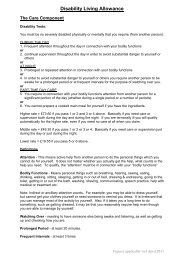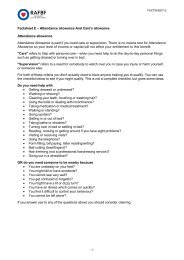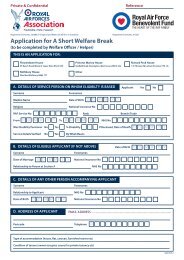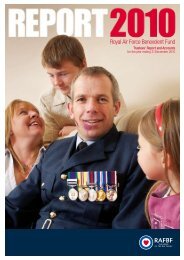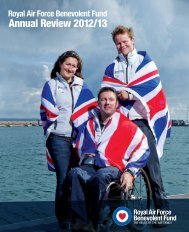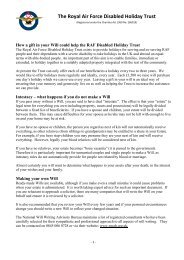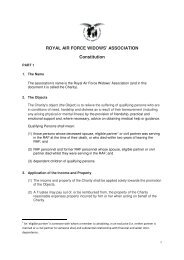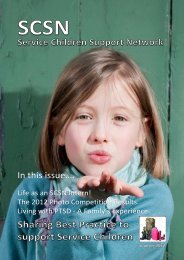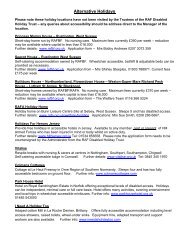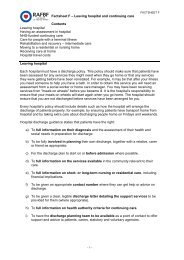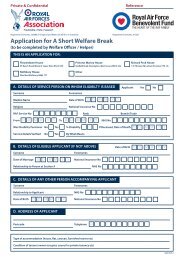2009 annual report and accounts - RAF Benevolent Fund
2009 annual report and accounts - RAF Benevolent Fund
2009 annual report and accounts - RAF Benevolent Fund
You also want an ePaper? Increase the reach of your titles
YUMPU automatically turns print PDFs into web optimized ePapers that Google loves.
Trustees’ Report continued<br />
Marketing Activities<br />
❚ <strong>Fund</strong>raising income amounted to £11.3m in return for an investment<br />
of £2.6m, reflecting a cost to income ratio of 1:4. During <strong>2009</strong> the<br />
Charity embarked on a 3 year investment to build its supporter base.<br />
The investment made over the year is expected to result in increased<br />
returns in future years.<br />
❚ Specific investment in direct marketing activity resulted in the<br />
acquisition of 6,000 new supporters.<br />
❚ Regional fundraising activity included the appointment of 26 <strong>RAF</strong>BF<br />
champions on <strong>RAF</strong> stations to support our fundraising <strong>and</strong> raise our<br />
profile amongst the serving community.<br />
❚ Press <strong>and</strong> public relations coverage increased by 33% over 2008<br />
<strong>and</strong> resulted in the Charity achieving a ranking of 50th position in<br />
the Top 100 Charity Br<strong>and</strong> Index, a benchmark of the public’s most<br />
recognised <strong>and</strong> trusted charities.<br />
❚ Two receptions were held at the House of Commons as part of the<br />
<strong>Fund</strong>’s aim to build greater parliamentary engagement with all<br />
mainstream political parties.<br />
❚ Several meetings were held between Regional Directors <strong>and</strong> their local<br />
Members of Parliament to increase awareness of the <strong>Fund</strong> <strong>and</strong> its<br />
charitable activities.<br />
Plans for Future Periods<br />
❚ Give priority to our traditional beneficiary base.<br />
❚ Provide Multi Use Games Areas, play parks <strong>and</strong><br />
qualified Youth Workers on principal <strong>RAF</strong> stations.<br />
❚ Complete the review of the joint homes begun in <strong>2009</strong>.<br />
❚ Attract donations from <strong>RAF</strong>, corporate <strong>and</strong> public supporters <strong>and</strong><br />
achieve maximum exposure through press articles, publicity material<br />
<strong>and</strong> <strong>Fund</strong> sponsored events.<br />
❚ Review the <strong>Fund</strong>’s investment strategy.<br />
❚ Identify <strong>and</strong> procure fit-for-purpose welfare <strong>and</strong> fundraising<br />
IT systems.<br />
❚ Oversee the redevelopment of 67 Portl<strong>and</strong> Place.<br />
❚ Develop the history of 67 Portl<strong>and</strong> Place for the public benefit.<br />
❚ Seek views of staff on conditions <strong>and</strong> terms of employment.<br />
Staff<br />
The Trustees continue to be grateful to all members of staff, particularly<br />
during a period of uncertainty surrounding the move to interim premises<br />
<strong>and</strong> the redevelopment of the <strong>Fund</strong>’s existing offices.<br />
The <strong>Fund</strong> seeks to be an employer of choice <strong>and</strong> continually reviews the<br />
level of remuneration <strong>and</strong> other benefits awarded to staff. These include<br />
encouragement <strong>and</strong> support to undertake training <strong>and</strong> development for<br />
the benefit of both the <strong>Fund</strong> <strong>and</strong> individual employees.<br />
Working with Others<br />
The majority of the <strong>Fund</strong>’s work involves making grants to beneficiaries,<br />
invariably through intermediaries. These include the personnel <strong>and</strong><br />
community support staff on <strong>RAF</strong> stations <strong>and</strong> other charities who<br />
undertake casework on our behalf. The latter includes SSAFA Forces<br />
Help, The Royal British Legion, The Royal Air Forces Association <strong>and</strong> other<br />
charities. The <strong>Fund</strong> is indebted to everyone who acts as a link between<br />
the <strong>Fund</strong> <strong>and</strong> its beneficiaries.<br />
In addition to casework support, the <strong>Fund</strong> is leading in several<br />
partnership initiatives <strong>and</strong> works increasingly closely with <strong>RAF</strong> community<br />
support staff at HQ Air Comm<strong>and</strong>, the Royal Air Forces Association, other<br />
<strong>RAF</strong> <strong>and</strong> Service related charities – including The Royal British Legion<br />
<strong>and</strong> SSAFA – Citizens Advice, Relate <strong>and</strong> other charitable organisations.<br />
This degree of cooperation leads to greater efficiency <strong>and</strong> economy of<br />
effort <strong>and</strong> is a key feature of the <strong>Fund</strong>’s strategic development.<br />
Volunteers<br />
The Trustees recognise the valuable contribution made by volunteers<br />
<strong>and</strong> wish to place on record their grateful thanks for their commitment.<br />
These include the caseworkers <strong>and</strong> helpers who act as the link between<br />
beneficiaries <strong>and</strong> the Charity, those who undertake fundraising activities<br />
on behalf of the <strong>Fund</strong>, <strong>and</strong> the committees of volunteers who meet<br />
regularly to assess applications for welfare support. No amounts are<br />
included in the financial statements to reflect the value of work<br />
undertaken by volunteers.<br />
Investment Policy <strong>and</strong> Returns<br />
The <strong>Fund</strong>’s investment strategy is to enhance the value of its investments<br />
through the adoption of a managed, diversified portfolio. The <strong>Fund</strong> uses a<br />
“total return” approach to measuring the performance of its investments.<br />
The return on investments in a year is the investment income<br />
generated <strong>and</strong> any capital gains or losses on the underlying investments.<br />
The investment manager has been tasked to deliver a return of at least<br />
RPI + 5% each year over rolling 5 year periods. In the shorter term,<br />
there is a secondary objective to outperform a composite benchmark<br />
of agreed indices.<br />
During <strong>2009</strong> the global financial markets recovered some of the ground<br />
lost during 2008. The <strong>Fund</strong>’s portfolio achieved a return of 19.3%,<br />
against a secondary benchmark of 19.4%. This return was reduced by<br />
the <strong>Fund</strong>’s exposure to commercial property, <strong>and</strong> a <strong>Fund</strong> decision to<br />
de-risk an element of the portfolio as the market recovered in the<br />
second half of the year.<br />
The <strong>Fund</strong> holds investments for long-term reserve requirements <strong>and</strong><br />
the Trustees are satisfied that their long-term investment strategy is<br />
appropriate. The Trustees <strong>and</strong> the Finance Committee continue to<br />
monitor carefully the performance of both the <strong>Fund</strong>’s investments<br />
<strong>and</strong> the investment manager.<br />
Reserves<br />
Free reserves are the resources which the <strong>Fund</strong> has or could make<br />
available to spend on any or all of the <strong>Fund</strong>’s purposes once it has met<br />
its commitments <strong>and</strong> covered its other planned expenditure.<br />
Free reserves exclude restricted, endowed <strong>and</strong> designated funds.<br />
They also exclude fixed assets, including Housing Trust properties<br />
<strong>and</strong> loans to beneficiaries.<br />
The <strong>Fund</strong> holds free reserves to ensure that it is able to meet the needs<br />
of its current <strong>and</strong> future beneficiaries given potential future risks. The<br />
<strong>Fund</strong> has broken down its reserves requirement into three categories.<br />
Reserves are held for the following reasons:<br />
❚ Short-term tactical needs (such as temporary setbacks in funding or<br />
cash flow difficulties).<br />
❚ Contingency needs (to enable the <strong>Fund</strong> to evolve <strong>and</strong> take advantage<br />
of strategic development opportunities <strong>and</strong> to meet unexpected calls<br />
on the <strong>Fund</strong> such as a disaster within the <strong>RAF</strong> family).<br />
❚ Long-term strategic needs (to reduce the risk posed by large external<br />
changes in the environment in which the <strong>Fund</strong> operates; for example,<br />
a large fall in stock markets).<br />
The <strong>Fund</strong> believes that the level of long-term strategic reserves should<br />
be based on funding requirements, given its anticipated expenditure in<br />
the next 5 years, the presence of an economic downturn, <strong>and</strong> related<br />
income <strong>and</strong> investment decline. The <strong>Fund</strong> believes that 4 years of<br />
expenditure would allow it to meet its commitments to its beneficiaries<br />
during this period. Given the long-term nature of the reserve<br />
requirement, the short-term volatility of financial markets <strong>and</strong> the<br />
time taken to make reserve adjustments, the <strong>Fund</strong> has set a reserve<br />
requirement range of 3-5 years’ core <strong>annual</strong> expenditure. The <strong>Fund</strong> will<br />
manage short-term <strong>and</strong> contingency requirements through its long-term<br />
strategic reserve<br />
The <strong>Fund</strong> believes that 6 months’ expenditure should be allocated to<br />
meet these short-term requirements <strong>and</strong> that these funds should be<br />
held in cash or near-cash. If the <strong>Fund</strong>’s reserves are projected to<br />
exceed the 5 years’ level, consideration will be given to de-risk an<br />
element of the portfolio.<br />
The reserves policy is reviewed each year as a part of the <strong>annual</strong><br />
planning process. Performance against the reserves policy is monitored<br />
during the year as part of regular financial management <strong>and</strong> is reflected<br />
as a key performance indicator at Board level.<br />
The net assets of the <strong>Fund</strong> at 31 December <strong>2009</strong> were £142.0m, an<br />
increase of £1.0m on 2008. Once fixed assets for charitable use,<br />
restricted <strong>and</strong> endowed funds have been taken into account, the level of<br />
reserves amounted to £90.0m, compared to £91.0m in 2008.<br />
The current level of free reserves falls within the range as defined in<br />
the policy above. Trustees will continue to monitor reserves against the<br />
policy in the coming year.<br />
Statement of Financial Activities<br />
The consolidated Statement of Financial Activities (SOFA) for the year is<br />
set out on pages 14 <strong>and</strong> 15 of the financial statements. A summary of<br />
the financial results is set out below.<br />
Incoming Resources<br />
The Charity’s income amounted to £17.7m (2008: £19.5m). Donations<br />
<strong>and</strong> legacies amounted to £11.2m. Of this sum, income from serving<br />
personnel <strong>and</strong> associated activities was just over £2m, once again<br />
reflecting the consistent support of the Royal Air Force for its principal<br />
welfare charity. Investment income fell to £3.6m in the year (2008:<br />
£5.2m), reflecting the effects of the global recession. Income from<br />
charitable activities was £1.5m, which included contributions from<br />
tenants of Housing Trust properties, care home fees <strong>and</strong> interest received<br />
from loans made to beneficiaries. Other income amounted to £1.3m.<br />
Cost of Generating <strong>Fund</strong>s<br />
Marketing <strong>and</strong> Communication costs increased to £2.6m (2008: £1.9m),<br />
reflecting the continuing implementation of the Charity’s evolving<br />
fundraising strategies to build voluntary income in future years. This<br />
amount includes £0.6m relating to public relations <strong>and</strong> building br<strong>and</strong><br />
awareness. Investment management fees, which are based on the<br />
market value of the funds invested, continued to reflect the lower value of<br />
the <strong>Fund</strong>’s portfolio<br />
Outgoing Resources<br />
During the year the <strong>Fund</strong> spent £24.2m (2008: £22.3m) in charitable<br />
expenditure <strong>and</strong> associated costs. Details of the services <strong>and</strong><br />
achievements of the <strong>Fund</strong> are included earlier in this <strong>report</strong>.<br />
Direct charitable expenditure amounted to £20.6m (2008: £19.3m),<br />
which included donations to other charities that provide help to the<br />
extended <strong>RAF</strong> family; these amounted to £2.6m <strong>and</strong> included a donation<br />
of £0.7m to <strong>RAF</strong> Leeming <strong>and</strong> £0.2m to <strong>RAF</strong> Wittering for their nurseries,<br />
<strong>and</strong> £0.4m to The Royal British Legion for a joint initiative with Citizens<br />
Advice. In addition to the amount spent on direct charitable expenditure<br />
as recorded in the SOFA, capital expenditure on housing through the<br />
<strong>Fund</strong>’s Housing Trust <strong>and</strong> loans to beneficiaries amounted to a further<br />
£4.0m (2008: £4.9m).<br />
Changes in Fixed Assets<br />
The movements in fixed assets during the year are set out in Note 9 to<br />
the financial statements.<br />
This Report was approved by the Board of Trustees on 01 June 2010.<br />
The Viscount Trenchard of Wolfeton DL<br />
Chairman of the <strong>RAF</strong> <strong>Benevolent</strong> <strong>Fund</strong><br />
90 Years at the heart of the <strong>RAF</strong> family <strong>RAF</strong>BF Report & Accounts 11



